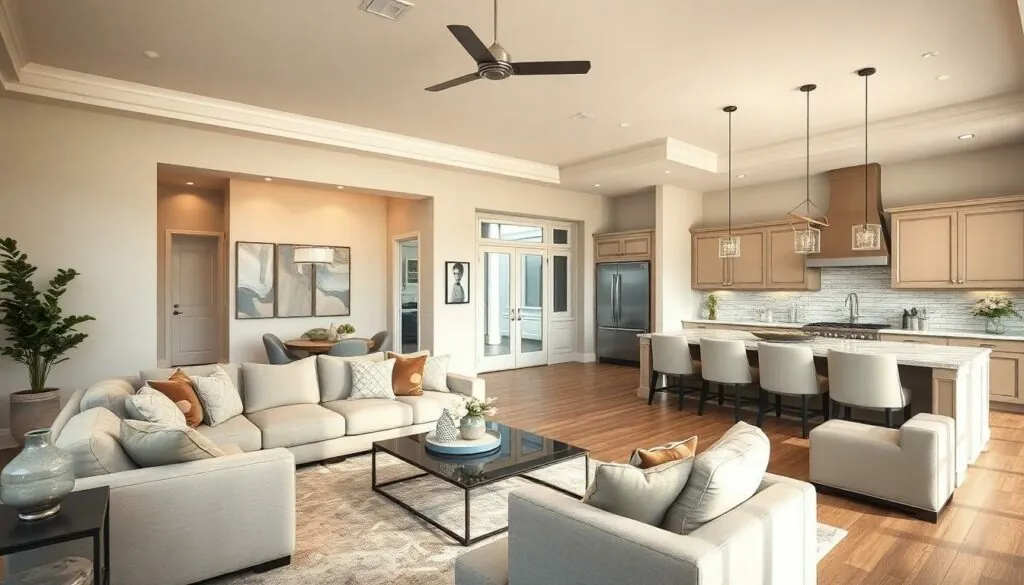Table of Contents
ToggleWalking into a model home is like stepping into a Pinterest board come to life. It’s where dreams of perfect living spaces take shape, and every corner whispers, “You could totally live like this!” From chic living rooms that make Netflix marathons feel glamorous to kitchens that could make even the most reluctant chef feel like a culinary genius, model home interiors are designed to dazzle.
Overview of Model Home Interiors
Model home interiors serve as a tangible representation of design potential. Each room showcases a specific aesthetic that appeals to various lifestyles. Living areas often prioritize comfort and style, featuring cozy seating arrangements that invite relaxation. Kitchens illustrate functionality paired with luxury. Modern appliances and ample counter space enhance culinary experiences.
Colors in model homes tend to focus on neutral palettes, creating a calming atmosphere. Subtle accents in decor add character without overwhelming the senses. Lighting design plays a crucial role, showcasing natural light through large windows and strategically placed fixtures. This combination encourages an inviting ambiance.
Layout is another essential aspect. Open floor plans promote social interaction and an airy feel. Separate areas for dining and entertainment highlight adaptability, catering to diverse homeowner needs. Bedrooms emphasize tranquility, with plush bedding and personal touches designed for restful nights.
Outdoor spaces complement interiors beautifully. Patios and gardens expand living areas, offering options for relaxation and entertainment. Tasteful landscaping enhances curb appeal, creating a welcoming entry experience.
Quality materials play a significant role in model home design. From flooring to cabinetry, durability meets elegance, ensuring lasting allure. Detailed craftsmanship demonstrates the commitment to excellence, making these homes desirable for potential buyers.
Ultimately, model home interiors present curated experiences that inspire potential homeowners. Each aspect, from layout to decor, contributes to an ideal lifestyle, making visits both informative and enjoyable.
Design Trends in Model Home Interiors

Model home interiors exhibit design trends that captivate and inspire. These spaces showcase the latest innovations and preferences in residential aesthetics.
Open Concept Living Spaces
Open concept living spaces dominate model home designs. This layout enhances flow between areas like the kitchen and living room. It encourages social interaction while maximizing natural light. Homebuyers appreciate the versatility that comes with these designs, allowing for varied furniture arrangements. Spaciousness in these areas creates a welcoming atmosphere, ideal for family gatherings and entertaining friends. Incorporating multiple seating options emphasizes comfort and style, making these homes appealing to a diverse audience.
Integration of Technology
Integration of technology in model homes represents a significant trend. Smart home features streamline daily tasks and enhance convenience through automation. Control systems for lighting, temperature, and security integrate seamlessly into the design, often hidden from view. Homebuyers value energy-efficient appliances that reduce utility costs while maintaining performance. Voice-activated devices in kitchens and living areas refine functionality, offering intuitive control over home environments. The incorporation of broadband connectivity further plays a crucial role, essential for remote work and online connectivity.
Key Elements of Model Home Interiors
Model home interiors focus on creating inviting spaces that resonate with potential buyers. They reflect an optimal blend of style and functionality, appealing to various lifestyles.
Color Schemes and Textures
Color schemes in model homes often emphasize neutrals, which foster a tranquil environment. Shades of gray, beige, and soft whites anchor the overall aesthetic, providing a versatile backdrop. Textures play a vital role, introducing warmth and depth to each space. For example, combining plush textiles with sleek surfaces transforms the ambiance. Accent colors, such as muted blues or greens, infuse energy while remaining subtle. Layered textures are strategically used to create visual interest, ensuring rooms feel cozy and stylish.
Furniture and Decor Choices
Furniture selections prioritize comfort and aesthetics in model homes. Sofas and chairs are often oversized to enhance relaxation, encouraging prospective buyers to envision themselves in the space. Decorative elements, including artwork and strategically placed plants, elevate the visual appeal. Each piece is chosen not just for looks but also for functionality, with storage solutions integrated seamlessly into designs. Lighting fixtures add character and ensure spaces remain bright, enhancing overall flow. Curtains and rugs harmonize the color palette, contributing to a cohesive look throughout the home.
Benefits of Model Home Interiors
Model home interiors offer several compelling advantages for potential homeowners. First, they provide a clear vision of design possibilities, showcasing how space can be utilized effectively. Visitors gain inspiration by seeing firsthand how various aesthetics harmonize within different rooms.
Layout efficiency stands out among benefits, as open floor plans create seamless transitions between living areas. This layout not only encourages social interaction but also maximizes natural light, contributing to a vibrant atmosphere.
Another key aspect is the integration of modern technology. Smart home features enhance convenience and streamline daily tasks, making life easier for residents. Homebuyers often prefer energy-efficient appliances and voice-activated systems, reflecting a growing trend towards sustainability.
Additionally, model homes highlight quality craftsmanship and materials. Visitors can appreciate the attention to detail, which sets a benchmark for what they might expect in their own homes. The use of textures and high-quality finishes enhances the overall appeal, creating inviting environments.
Color schemes also play an important role in shaping atmosphere. Neutral palettes foster tranquility, while pops of color introduce visual interest. This thoughtful use of color makes spaces feel both relaxing and dynamic at once.
Ultimately, model home interiors serve as practical showcases that inspire potential buyers. They encapsulate the essence of contemporary living, balancing style and functionality. Experiencing these spaces allows homebuyers to envision their future home within a curated design framework.
Model home interiors offer a unique glimpse into the possibilities of modern living. They combine style and functionality in a way that resonates with potential homeowners. The carefully curated spaces not only inspire but also provide practical solutions for everyday life.
By showcasing the latest trends in design and technology, these homes reflect the evolving preferences of today’s buyers. Each element is thoughtfully chosen to create an inviting atmosphere that encourages connection and comfort.
Visiting a model home isn’t just about visual appeal; it’s an opportunity to envision a lifestyle that balances elegance with practicality. These interiors serve as a powerful reminder of what’s achievable in home design, making them invaluable for anyone looking to create their dream space.





